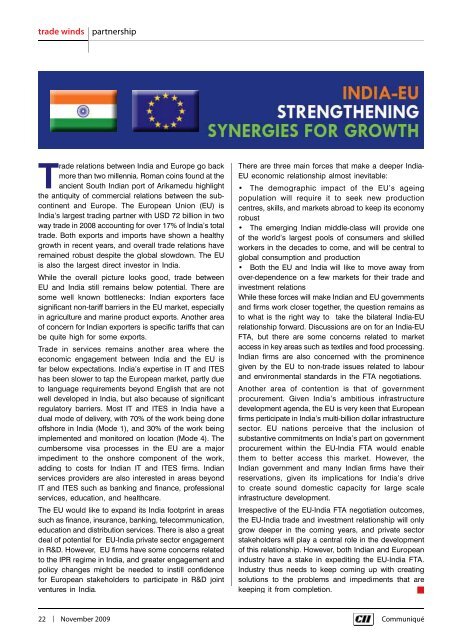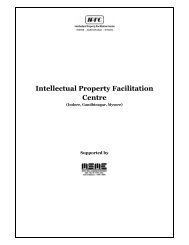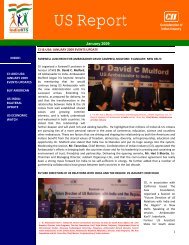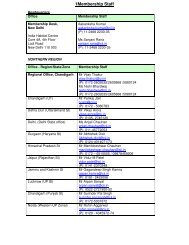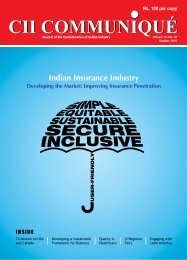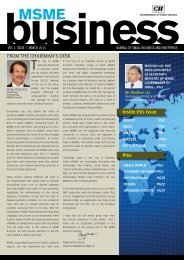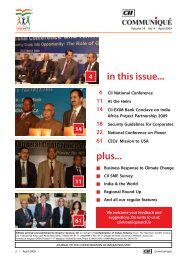Communiqué November 2009 | 1 - CII
Communiqué November 2009 | 1 - CII
Communiqué November 2009 | 1 - CII
- No tags were found...
You also want an ePaper? Increase the reach of your titles
YUMPU automatically turns print PDFs into web optimized ePapers that Google loves.
trade windspartnershipTrade relations between India and Europe go backmore than two millennia. Roman coins found at theancient South Indian port of Arikamedu highlightthe antiquity of commercial relations between the subcontinentand Europe. The European Union (EU) isIndia’s largest trading partner with USD 72 billion in twoway trade in 2008 accounting for over 17% of India’s totaltrade. Both exports and imports have shown a healthygrowth in recent years, and overall trade relations haveremained robust despite the global slowdown. The EUis also the largest direct investor in India.While the overall picture looks good, trade betweenEU and India still remains below potential. There aresome well known bottlenecks: Indian exporters facesignificant non-tariff barriers in the EU market, especiallyin agriculture and marine product exports. Another areaof concern for Indian exporters is specific tariffs that canbe quite high for some exports.Trade in services remains another area where theeconomic engagement between India and the EU isfar below expectations. India’s expertise in IT and ITEShas been slower to tap the European market, partly dueto language requirements beyond English that are notwell developed in India, but also because of significantregulatory barriers. Most IT and ITES in India have adual mode of delivery, with 70% of the work being doneoffshore in India (Mode 1), and 30% of the work beingimplemented and monitored on location (Mode 4). Thecumbersome visa processes in the EU are a majorimpediment to the onshore component of the work,adding to costs for Indian IT and ITES firms. Indianservices providers are also interested in areas beyondIT and ITES such as banking and finance, professionalservices, education, and healthcare.The EU would like to expand its India footprint in areassuch as finance, insurance, banking, telecommunication,education and distribution services. There is also a greatdeal of potential for EU-India private sector engagementin R&D. However, EU firms have some concerns relatedto the IPR regime in India, and greater engagement andpolicy changes might be needed to instill confidencefor European stakeholders to participate in R&D jointventures in India.There are three main forces that make a deeper India-EU economic relationship almost inevitable: population will require it to seek new productioncentres, skills, and markets abroad to keep its economyrobust of the world’s largest pools of consumers and skilledworkers in the decades to come, and will be central toglobal consumption and production over-dependence on a few markets for their trade andinvestment relationsWhile these forces will make Indian and EU governmentsand firms work closer together, the question remains asto what is the right way to take the bilateral India-EUrelationship forward. Discussions are on for an India-EUFTA, but there are some concerns related to marketaccess in key areas such as textiles and food processing.Indian firms are also concerned with the prominencegiven by the EU to non-trade issues related to labourand environmental standards in the FTA negotiations.Another area of contention is that of governmentprocurement. Given India’s ambitious infrastructuredevelopment agenda, the EU is very keen that Europeanfirms perticipate in India’s multi-billion dollar infrastructuresector. EU nations perceive that the inclusion ofsubstantive commitments on India’s part on governmentprocurement within the EU-India FTA would enablethem to better access this market. However, theIndian government and many Indian firms have theirreservations, given its implications for India’s driveto create sound domestic capacity for large scaleinfrastructure development.Irrespective of the EU-India FTA negotiation outcomes,the EU-India trade and investment relationship will onlygrow deeper in the coming years, and private sectorstakeholders will play a central role in the developmentof this relationship. However, both Indian and Europeanindustry have a stake in expediting the EU-India FTA.Industry thus needs to keep coming up with creatingsolutions to the problems and impediments that arekeeping it from completion.22 | <strong>November</strong> <strong>2009</strong> Communiqué


